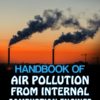Global agricultural feeds over 7 billion people, but is also a leading cause of environmental degradation. Understanding how alternative agricultural production systems, agricultural input efficiency, and food choice drive environmental degradation is necessary for reducing agriculture’s environmental impacts. Concern about the environmental impact of repeated pesticide use has prompted research into the environmental fate of these agents, which can emigrate from treated fields to air, other lands, and water bodies. The importance of agricultural pesticides in developing countries is undeniable.
The book starts with a study that needs to understand the linkages between diets, agricultural production practices, and environmental degradation if we are to reduce agriculture’s environmental impacts while providing a secure food supply for a growing global population. Food production systems such as organic agriculture and grass-fed beef have been proposed as potential ways to reduce agriculture’s environmental impacts. Organic agriculture, for example, is often promoted as having lower environmental impacts relative to high-input conventional systems because it replaces agrochemical inputs with natural inputs such as manure or with ecosystem services such as pest control. In the last five decades, pesticide usages increased the quantity and improved the quality of food. However, with the increasing amounts of their usage, concern about their adverse effects on nontarget organisms, including human beings, has also grown. The purpose of this literature is to explain the nature of pesticides and their history, classification, risks, and effects on health and the environment. It focuses on soil erosion from agriculture and mining, which poses a threat to tropical stream ecosystems.
Additionally, the book presents an emphasis on the environmental impact of peanut production under different levels of nitrogen fertilization; a tool for evaluation of greenhouse gases emissions from agriculture and food processing; environmental impacts of the beef production chain; the environmental impact of chemically-produced protein hydrolysate from leather waste vs. enzymatically-produced protein hydrolysate from legume grains.
Moreover, it focuses on the pathways to sustainable intensification through crop water management. Lastly, the book closes with a discussion on farmers’ adaptation strategies to climate change and their implications. Overall, this book examines the environmental impact through the agricultural activities in the 21st era and promoting to the future with lessons learned from the past.














Reviews
There are no reviews yet.